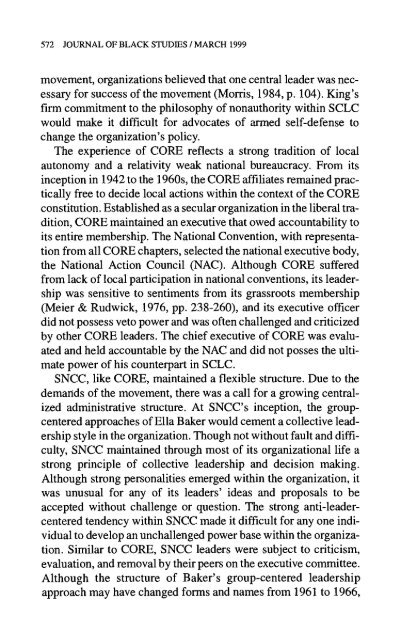MXGM Self-Defence Manual
MXGM Self-Defence Manual
MXGM Self-Defence Manual
Create successful ePaper yourself
Turn your PDF publications into a flip-book with our unique Google optimized e-Paper software.
572 JOURNAL OF BLACK STUDIES / MARCH 1999<br />
movement, organizations believed that one central leader was necessary<br />
for success of the movement (Morris, 1984, p. 104). King's<br />
firm commitment to the philosophy of nonauthority within SCLC<br />
would make it difficult for advocates of armed self-defense to<br />
change the organization's policy.<br />
The experience of CORE reflects a strong tradition of local<br />
autonomy and a relativity weak national bureaucracy. From its<br />
inception in 1942 to the 1960s, the CORE affiliates remained practically<br />
free to decide local actions within the context of the CORE<br />
constitution. Established as a secular organization in the liberal tradition,<br />
CORE maintained an executive that owed accountability to<br />
its entire membership. The National Convention, with representation<br />
from all CORE chapters, selected the national executive body,<br />
the National Action Council (NAC). Although CORE suffered<br />
from lack of local participation in national conventions, its leadership<br />
was sensitive to sentiments from its grassroots membership<br />
(Meier & Rudwick, 1976, pp. 238-260), and its executive officer<br />
did not possess veto power and was often challenged and criticized<br />
by other CORE leaders. The chief executive of CORE was evaluated<br />
and held accountable by the NAC and did not posses the ultimate<br />
power of his counterpart in SCLC.<br />
SNCC, like CORE, maintained a flexible structure. Due to the<br />
demands of the movement, there was a call for a growing centralized<br />
administrative structure. At SNCC's inception, the groupcentered<br />
approaches of Ella Baker would cement a collective leadership<br />
style in the organization. Though not without fault and difficulty,<br />
SNCC maintained through most of its organizational life a<br />
strong principle of collective leadership and decision making.<br />
Although strong personalities emerged within the organization, it<br />
was unusual for any of its leaders' ideas and proposals to be<br />
accepted without challenge or question. The strong anti-leadercentered<br />
tendency within SNCC made it difficult for any one individual<br />
to develop an unchallenged power base within the organization.<br />
Similar to CORE, SNCC leaders were subject to criticism,<br />
evaluation, and removal by their peers on the executive committee.<br />
Although the structure of Baker's group-centered leadership<br />
approach may have changed forms and names from 1961 to 1966,


